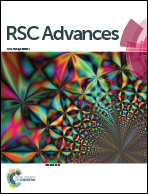Sterically hindered selenoether ligands: palladium(ii) complexes as catalytic activators for Suzuki–Miyaura coupling†
Abstract
2-Hydroxy/(benzyloxy)-3,5-di-tert-butyl benzaldehyde reacts with PhSeCH2CH2NH2 resulting in a sterically hindered selenoether ligand (Schiff base) [2–HO–3,5–(C(CH3)3)2–C6H2–C![[double bond, length as m-dash]](https://www.rsc.org/images/entities/char_e001.gif) N–(CH2)2SePh] (L1)/[2–PhCH2O–3,5–(C(CH3)3)2–C6H2–CH2–NH–(CH2)2SePh] (L2). The reactions of L1 and L2 with Na2PdCl4 in methanol and acetone–water mixture at room temperature have resulted in complexes [PdCl (L1-H)] (1) and [PdCl2(L2)] (2)], respectively. Both the complexes and their ligands have been characterized with 1H, 13C{1H} and 77Se{1H} NMR spectroscopy. The molecular structures of complexes 1 and 2 have been determined with single crystal X-ray diffraction. The Pd–Se bond lengths in 1 and 2 are 2.370(1) and 2.366(1) Å, respectively. The geometry around palladium in both the complexes is nearly square planar. Complexes 1 and 2 (0.1 mol% Pd) have been found efficient as catalysts for Suzuki–Miyaura C–C coupling reactions in the presence of K2CO3 in ethanol. The catalysis in water with complex 1 in the presence of K2CO3 was found feasible but with low conversion (up to 40%). The efficiency of 1 in carrying out the coupling is marginally better than that of 2.
N–(CH2)2SePh] (L1)/[2–PhCH2O–3,5–(C(CH3)3)2–C6H2–CH2–NH–(CH2)2SePh] (L2). The reactions of L1 and L2 with Na2PdCl4 in methanol and acetone–water mixture at room temperature have resulted in complexes [PdCl (L1-H)] (1) and [PdCl2(L2)] (2)], respectively. Both the complexes and their ligands have been characterized with 1H, 13C{1H} and 77Se{1H} NMR spectroscopy. The molecular structures of complexes 1 and 2 have been determined with single crystal X-ray diffraction. The Pd–Se bond lengths in 1 and 2 are 2.370(1) and 2.366(1) Å, respectively. The geometry around palladium in both the complexes is nearly square planar. Complexes 1 and 2 (0.1 mol% Pd) have been found efficient as catalysts for Suzuki–Miyaura C–C coupling reactions in the presence of K2CO3 in ethanol. The catalysis in water with complex 1 in the presence of K2CO3 was found feasible but with low conversion (up to 40%). The efficiency of 1 in carrying out the coupling is marginally better than that of 2.


 Please wait while we load your content...
Please wait while we load your content...